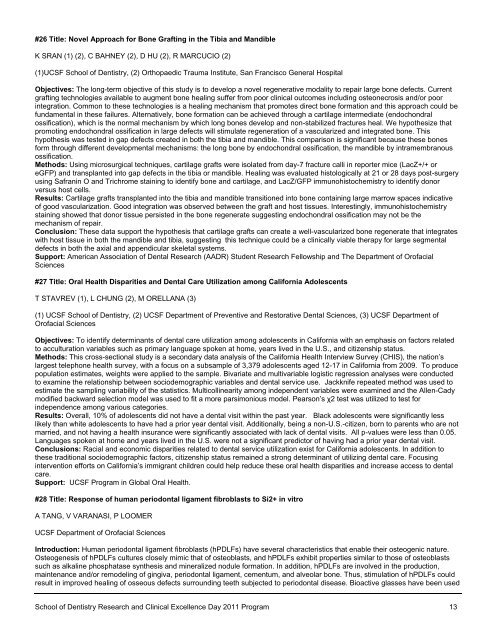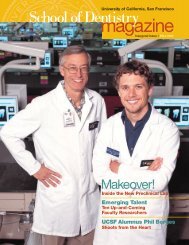Acknowledgements - UCSF School of Dentistry - University of ...
Acknowledgements - UCSF School of Dentistry - University of ...
Acknowledgements - UCSF School of Dentistry - University of ...
Create successful ePaper yourself
Turn your PDF publications into a flip-book with our unique Google optimized e-Paper software.
#26 Title: Novel Approach for Bone Grafting in the Tibia and Mandible<br />
K SRAN (1) (2), C BAHNEY (2), D HU (2), R MARCUCIO (2)<br />
(1)<strong>UCSF</strong> <strong>School</strong> <strong>of</strong> <strong>Dentistry</strong>, (2) Orthopaedic Trauma Institute, San Francisco General Hospital<br />
Objectives: The long-term objective <strong>of</strong> this study is to develop a novel regenerative modality to repair large bone defects. Current<br />
grafting technologies available to augment bone healing suffer from poor clinical outcomes including osteonecrosis and/or poor<br />
integration. Common to these technologies is a healing mechanism that promotes direct bone formation and this approach could be<br />
fundamental in these failures. Alternatively, bone formation can be achieved through a cartilage intermediate (endochondral<br />
ossification), which is the normal mechanism by which long bones develop and non-stabilized fractures heal. We hypothesize that<br />
promoting endochondral ossification in large defects will stimulate regeneration <strong>of</strong> a vascularized and integrated bone. This<br />
hypothesis was tested in gap defects created in both the tibia and mandible. This comparison is significant because these bones<br />
form through different developmental mechanisms: the long bone by endochondral ossification, the mandible by intramembranous<br />
ossification.<br />
Methods: Using microsurgical techniques, cartilage grafts were isolated from day-7 fracture calli in reporter mice (LacZ+/+ or<br />
eGFP) and transplanted into gap defects in the tibia or mandible. Healing was evaluated histologically at 21 or 28 days post-surgery<br />
using Safranin O and Trichrome staining to identify bone and cartilage, and LacZ/GFP immunohistochemistry to identify donor<br />
versus host cells.<br />
Results: Cartilage grafts transplanted into the tibia and mandible transitioned into bone containing large marrow spaces indicative<br />
<strong>of</strong> good vascularization. Good integration was observed between the graft and host tissues. Interestingly, immunohistochemistry<br />
staining showed that donor tissue persisted in the bone regenerate suggesting endochondral ossification may not be the<br />
mechanism <strong>of</strong> repair.<br />
Conclusion: These data support the hypothesis that cartilage grafts can create a well-vascularized bone regenerate that integrates<br />
with host tissue in both the mandible and tibia, suggesting this technique could be a clinically viable therapy for large segmental<br />
defects in both the axial and appendicular skeletal systems.<br />
Support: American Association <strong>of</strong> Dental Research (AADR) Student Research Fellowship and The Department <strong>of</strong> Or<strong>of</strong>acial<br />
Sciences<br />
#27 Title: Oral Health Disparities and Dental Care Utilization among California Adolescents<br />
T STAVREV (1), L CHUNG (2), M ORELLANA (3)<br />
(1) <strong>UCSF</strong> <strong>School</strong> <strong>of</strong> <strong>Dentistry</strong>, (2) <strong>UCSF</strong> Department <strong>of</strong> Preventive and Restorative Dental Sciences, (3) <strong>UCSF</strong> Department <strong>of</strong><br />
Or<strong>of</strong>acial Sciences<br />
Objectives: To identify determinants <strong>of</strong> dental care utilization among adolescents in California with an emphasis on factors related<br />
to acculturation variables such as primary language spoken at home, years lived in the U.S., and citizenship status.<br />
Methods: This cross-sectional study is a secondary data analysis <strong>of</strong> the California Health Interview Survey (CHIS), the nation’s<br />
largest telephone health survey, with a focus on a subsample <strong>of</strong> 3,379 adolescents aged 12-17 in California from 2009. To produce<br />
population estimates, weights were applied to the sample. Bivariate and multivariable logistic regression analyses were conducted<br />
to examine the relationship between sociodemographic variables and dental service use. Jackknife repeated method was used to<br />
estimate the sampling variability <strong>of</strong> the statistics. Multicollinearity among independent variables were examined and the Allen-Cady<br />
modified backward selection model was used to fit a more parsimonious model. Pearson’s χ2 test was utilized to test for<br />
independence among various categories.<br />
Results: Overall, 10% <strong>of</strong> adolescents did not have a dental visit within the past year. Black adolescents were significantly less<br />
likely than white adolescents to have had a prior year dental visit. Additionally, being a non-U.S.-citizen, born to parents who are not<br />
married, and not having a health insurance were significantly associated with lack <strong>of</strong> dental visits. All p-values were less than 0.05.<br />
Languages spoken at home and years lived in the U.S. were not a significant predictor <strong>of</strong> having had a prior year dental visit.<br />
Conclusions: Racial and economic disparities related to dental service utilization exist for California adolescents. In addition to<br />
these traditional sociodemographic factors, citizenship status remained a strong determinant <strong>of</strong> utilizing dental care. Focusing<br />
intervention efforts on California’s immigrant children could help reduce these oral health disparities and increase access to dental<br />
care.<br />
Support: <strong>UCSF</strong> Program in Global Oral Health.<br />
#28 Title: Response <strong>of</strong> human periodontal ligament fibroblasts to Si2+ in vitro<br />
A TANG, V VARANASI, P LOOMER<br />
<strong>UCSF</strong> Department <strong>of</strong> Or<strong>of</strong>acial Sciences<br />
Introduction: Human periodontal ligament fibroblasts (hPDLFs) have several characteristics that enable their osteogenic nature.<br />
Osteogenesis <strong>of</strong> hPDLFs cultures closely mimic that <strong>of</strong> osteoblasts, and hPDLFs exhibit properties similar to those <strong>of</strong> osteoblasts<br />
such as alkaline phosphatase synthesis and mineralized nodule formation. In addition, hPDLFs are involved in the production,<br />
maintenance and/or remodeling <strong>of</strong> gingiva, periodontal ligament, cementum, and alveolar bone. Thus, stimulation <strong>of</strong> hPDLFs could<br />
result in improved healing <strong>of</strong> osseous defects surrounding teeth subjected to periodontal disease. Bioactive glasses have been used<br />
<strong>School</strong> <strong>of</strong> <strong>Dentistry</strong> Research and Clinical Excellence Day 2011 Program 13




